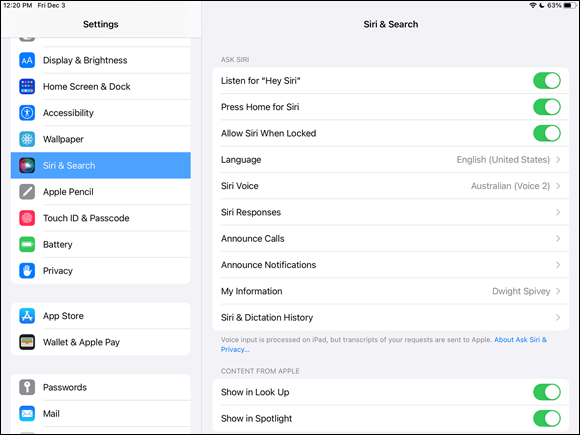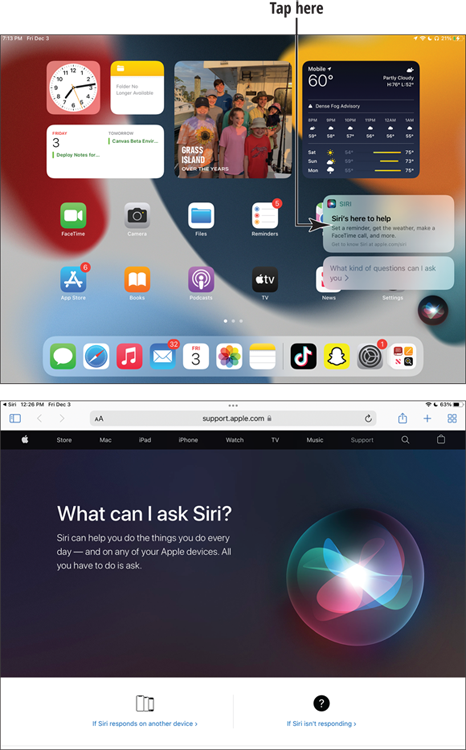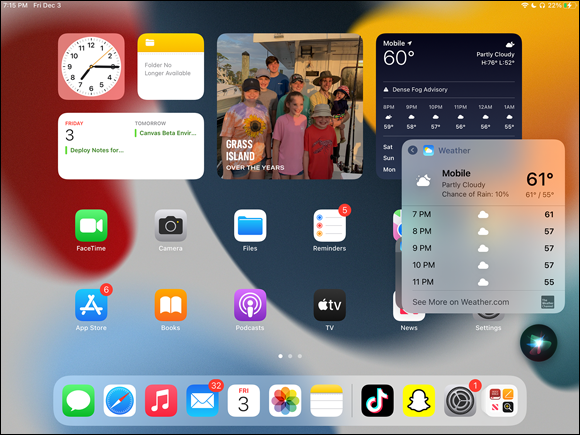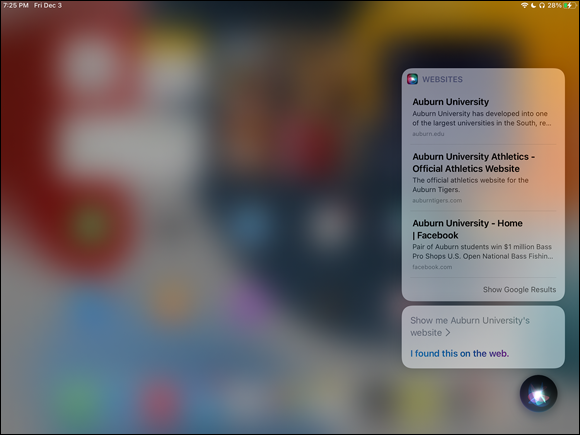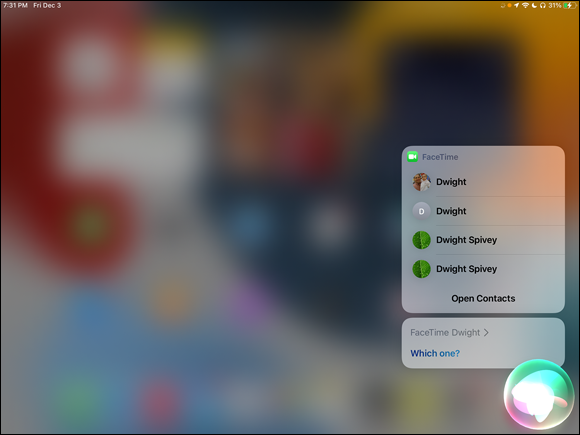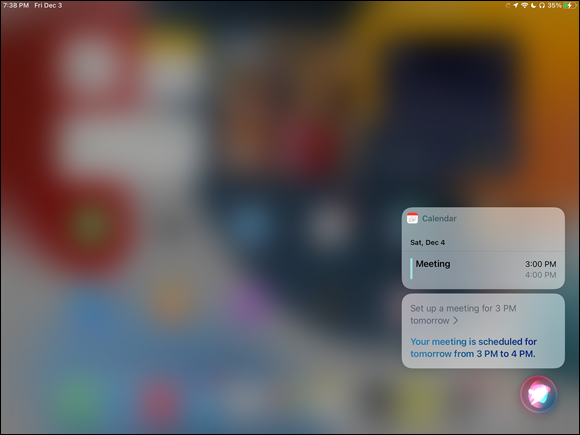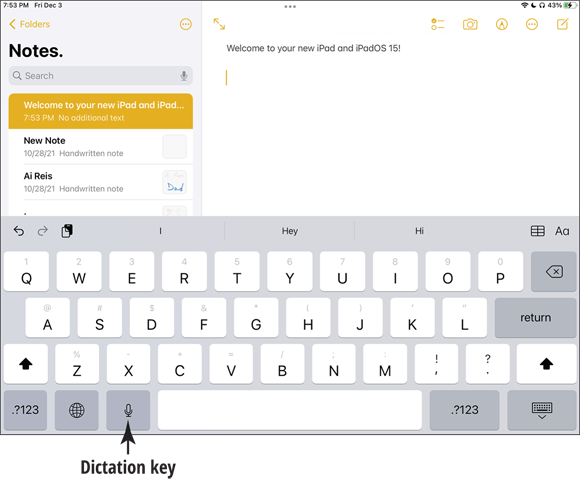Chapter 5
Conversing with Siri
IN THIS CHAPTER
![]() Activate Siri
Activate Siri
![]() Get suggestions and call contacts
Get suggestions and call contacts
![]() Create reminders and alerts
Create reminders and alerts
![]() Add tasks to your calendar
Add tasks to your calendar
![]() Play music and get directions
Play music and get directions
![]() Ask for facts and search the web
Ask for facts and search the web
![]() Send messages, dictate, and translate
Send messages, dictate, and translate
![]() Get helpful tips
Get helpful tips
One of the most talked about (pun intended) features on your iPad is Siri, a personal assistant feature that responds to the commands you speak to your iPad. With Siri, you can ask for nearby restaurants, and a list appears. You can dictate your email messages rather than type them. You can open apps or the App Store itself with a voice command. Placing a FaceTime call to your mother is as simple as saying, “Call Mom.” Want to know the capital of Rhode Island? Just ask. Siri checks several online sources to answer questions ranging from the result of a mathematical equation to the next scheduled flight to Rome (Italy or Georgia). You can have Siri search photos and videos and locate what you need by date, location, or album name. Ask Siri to remind you about an app you’re working in, such as Safari, Mail, or Notes, at a later time so that you can pick up where you left off.
You can also have Siri perform tasks, such as returning calls and controlling Music. Siri can play music at your request and identify tagged songs (songs that contain embedded information that identifies them by categories such as artist or genre) for you. You can also hail a ride with Uber or Lyft, watch live TV just by saying “Watch ESPN” (or, say, another app you might use, such as Netflix), find tagged photos, make payments with some third-party apps, and more.
With iPadOS 15, Siri can offer you curated suggestions for Safari, Maps, and Podcasts. Siri also features new voice technology that allows it to sound more natural and smooth, particularly when speaking long phrases. Another nice update to Siri in iPadOS 15 is that processing for Siri requests is now performed entirely on your iPad, if it has an A12 Bionic chipset or newer. This means that requests you make of Siri are performed much faster than before, which is always a treat.
Activate Siri
When you first turn on your iPad, Apple walks you through the process of registering and setting it up onscreen. Tap Get Started to begin making settings for your location, using iCloud, and so on, and at one point, you will see the option to activate Siri. As you begin to use your device, the iPad reminds you about using Siri by displaying a message.
If you didn’t activate Siri during the registration process, you can use Settings to turn Siri on by following these steps:
- Tap the Settings icon on the Home screen.
- Tap Siri & Search (see Figure 5-1).
In the Siri & Search dialog on the right, toggle the On/Off switch to On (green) to activate any or all of the following features:
If you want to be able to activate Siri for hands-free use, toggle the Listen for “Hey Siri” switch to turn on the feature. When you first enable “Hey Siri,” you’ll be prompted to set up the feature. Just walk through the steps to enable it and continue.
With this feature enabled, just say “Hey, Siri,” and Siri opens up, ready for a command. In addition, with streaming voice recognition, Siri displays in text what it’s hearing as you speak, so you can verify that it has understood you correctly. This streaming feature makes the whole process of interacting with Siri faster.
 Some iPad models must be plugged into a power source to use the “Hey Siri” feature, and others don’t. Visit
Some iPad models must be plugged into a power source to use the “Hey Siri” feature, and others don’t. Visit https://support.apple.com/en-us/HT209014to find out whether your model supports using “Hey Siri” without needing to be plugged in.- Press Home/Top Button for Siri requires you to press the Home button or the top button (for iPads without a Home button) to activate Siri.
- Allow Siri When Locked allows you to use Siri even when the iPad is locked.
 Be careful with enabling this option. Others with nefarious intentions may be able to use it to access personal and sensitive information.
Be careful with enabling this option. Others with nefarious intentions may be able to use it to access personal and sensitive information.- If you want to change the language Siri uses, tap Language and choose a different language in the list that appears.
To change the nationality or gender of Siri’s voice from American to British or Australian (for example), or from female to male, tap Siri Voice and make your selections. Some nationalities have multiple voices that you can select.
 Give several nationalities and genders a shot. Over the years, I’ve found that the Australian female voice (Voice 2) coupled with the English (United States) Language option was easier for me to understand, for whatever reason.
Give several nationalities and genders a shot. Over the years, I’ve found that the Australian female voice (Voice 2) coupled with the English (United States) Language option was easier for me to understand, for whatever reason.- Let Siri know about your contact information by tapping My Information and selecting yourself from your Contacts.
Discover All That Siri Can Do
Siri allows you to interact by voice with many apps on your iPad.
You can pose questions or ask to do something like make a FaceTime call or add an appointment to your calendar, for example. Siri can also search the Internet or use an informational service called Wolfram|Alpha to provide information on just about any topic.
To see examples of what Siri can do for you, engage Siri and say “What kind of questions can I ask you?” A dialog will appear onscreen telling you “Siri’s here to help”; tap that dialog to visit www.apple.com/siri in Safari (or whatever your default browser is), as shown in Figure 5-2.
Siri also checks with Wikipedia, Bing, and Twitter to get you the information you ask for. In addition, you can use Siri to tell the iPad to return a call, play your voicemail, open and search the App Store, control Music playback, dictate text messages, and much more.
Siri learns your daily habits and will offer suggestions throughout the day when appropriate. For example, say that you usually stop by the local coffee shop around the same time each morning and use the shop’s app to order a drink from your iPad. Siri picks up on this activity and eventually begins asking if you’d like to order a drink when you’re within proximity of the coffee shop.
With iPadOS 15, Siri is much better at maintaining the context of questions. For example, you can ask something like “Where is the nearest Starbucks location?” and then follow it with “What’s the phone number there?” Siri will automatically know you’re asking for the phone number of the Starbucks location it finds. It’s not always perfect, but this feature does make for a vastly improved Siri experience.
Siri knows what app you’re using, though you don’t have to have that app open to make a request involving it. However, if you’re in the Messages app, you can make a statement like “Tell Sasha I’ll be late,” and Siri knows that you want to send a message. You can also ask Siri to remind you about what you’re working on, and Siri notes what you’re working on and which app you’re working in, and reminds you about it at a later time that you specify.
New to iPadOS 15, Siri is now able to announce possibly time-sensitive notifications when you’re wearing AirPods (second generation or newer). For example, if you’re in the aforementioned coffee shop and it’s getting close to time for a meeting, Siri will interrupt whatever you’re listening to so that you’re aware of the upcoming appointment.
Siri requires no preset structure for your questions; you can phrase things in several ways. For example, you might say, “Where am I?” to see a map of your current location, or you could say, “What is my current location?” or “What address is this?” and get the same results.
If you ask a question about, say, the weather, Siri responds to you both verbally and with text information (see Figure 5-3; tap the small arrow next to the temperature when it displays to see a bit more info, as I’ve done in the figure). Or Siri might open a form, as with email, or provide a graphic display for some items, such as maps. When a result appears, you can tap it to make a choice or open a related app.
Siri works with FaceTime, the App Store, Music, Messages, Reminders, Calendar, Maps, Mail, Weather, Stocks, Clock, Contacts, Notes, social media apps (such as Twitter), and Safari (see Figure 5-4). In the following sections, I provide a quick guide to some of the most useful ways you can use Siri.
Get Suggestions
Siri anticipates your needs by making suggestions when you swipe from left to right on the Home screen and tap within the Search field at the top of the screen. Siri lists contacts you’ve communicated with recently, apps you’ve used, and nearby businesses, such as restaurants, gas stations, or coffee spots. If you tap an app in the suggestions, it opens displaying the last viewed or listened to item.
Additionally, Siri lists news stories that may be of interest to you based on items you’ve viewed before.
Call Contacts via FaceTime
First, make sure that the person you want to call is entered in your Contacts app and include that person’s phone number in their record. If you want to call somebody by stating your relationship to them, such as “Call sister,” be sure to enter that relationship in the Add Related Name field in her contact record. Also make sure that the settings for Siri (refer to Figure 5-1) include your own contact name in the My Information field. (See Chapter 7 for more about creating contact records.)
To call contacts via FaceTime, follow these steps:
- Press and hold the Home button (or say “Hey, Siri,” if you’re using that feature) until Siri appears.
- Speak a command, such as “Make a FaceTime call to Cindy,” or say “FaceTime Mom.”
- If you have more than one contact who might match a spoken name, Siri responds with a list of possible matches (see Figure 5-5). Tap one in the list or state the correct contact’s name to proceed.
- The call is placed. To end the call before it completes, press the Home button and then tap End.
Create Reminders and Alerts
You can also use Siri with the Reminders app:
- To create a reminder or alert, press and hold the Home button or Top button (depending on your iPad model) and then speak a command, such as “Remind me to call Dad on Thursday at 10 a.m.” or “Wake me up tomorrow at 6:15 a.m.”
- A preview of the reminder or alert is displayed (see Figure 5-6). Tell Siri to Cancel or Remove if you change your mind.
- If you want a reminder ahead of the event that you created, activate Siri and speak a command, such as “Remind me tonight about the play on Thursday at 8 p.m.” A second reminder is created, which you can confirm or cancel if you change your mind.
Add Tasks to Your Calendar
You can also set up events on your Calendar using Siri:
- Press and hold the Home or Top button and then speak a phrase, such as “Set up a meeting at 3 p.m. tomorrow.”
- Siri sets up the appointment (see Figure 5-7) and may ask you to let it know if you want to make changes.
Play Music
You can use Siri to play music from the Music app:
- Press and hold the Home or Top button until Siri appears.
- To play music, speak a command, such as “Play music” or “Play Jazz radio station” to play a specific song, album, or radio station, as shown in Figure 5-8.
Apple has integrated Siri into Shazam, a music identifier app, to identify music. To use this integration:
- When you’re near an audio source playing music, press and hold the Home button or Top button to activate Siri.
- Ask Siri a question, such as “What music is playing?” or “What’s this song?”
- Siri listens for a bit. If Siri recognizes the song, it shows you the song name, artist, any other available information, and the ability to purchase the music in the iTunes Store.
Get Directions
You can use the Maps app and Siri to find your current location, get directions, find nearby businesses (such as restaurants or a bank), or get a map of another location. Be sure to turn on Location Services to allow Siri to know your current location (go to Settings and tap Privacy ⇒ Location Services; make sure Location Services is on and that Siri & Dictation is turned on further down in these settings).
Here are some of the commands that you can try to get directions or a list of nearby businesses:
- “Where am I?” Displays a map of your current location.
- “Where is Big Potato Company?” Displays a map of the city where that restaurant is located, as shown in Figure 5-9.
- “Find pizza restaurants.” Displays a list of restaurants near your current location. Tap one to display a map of its location.
- “Find PNC Bank.” Displays a map with the location of the indicated business (or in some cases, several nearby locations, such as a bank branch and all ATMs).
- “Get directions to Auburn Arena.” Loads a map with a route drawn and provides a narration of directions to the site from your current location.
Ask for Facts
Siri uses numerous information sources, such as Wolfram|Alpha, Wikipedia, and Bing, to look up facts in response to questions. You can ask “What is the capital of Kansas?” or “What is the square root of 2,300?” or “How large is Mars?” Just press and hold the Home button or Top button and ask your question; Siri consults its resources and returns a set of relevant facts.
You can also get information about other things, such as the weather, stocks, or a scientific fact. Just say a phrase like one of these to get what you need:
- “What is the weather?” displays the weather report for your current location. If you want weather in another location, just specify the location in your question.
- “What is the price of Apple stock?” gets you the current price of the stock or the price of the stock when the stock market last closed.
- “How hot is the sun?” results in Siri’s telling you the temperature of the sun, in various unit conversions.
Search the Web
Although Siri can use its resources to respond to specific requests such as, “Who is the Queen of England?”, more general requests for information will cause Siri to search further on the web. Siri can also search Twitter for comments related to your search.
For example, if you speak a phrase, such as “Find a website about birds” or “Find information about the World Series,” Siri can respond in a couple of ways. The app can simply display a list of search results by using the default search engine specified in your settings for Safari, or Siri can suggest, “If you like, I can search the web for such and such.” In the first instance, just tap a result to go to that website. In the second instance, you can confirm that you want to search the web or cancel.
Send Email, Messages, or Tweets
You can create an email or an instant message using Siri and existing contacts. For example, if you say “Email Fr. Stephen Campbell,” a form opens that is already addressed to that stored contact. Siri asks for a subject and then a message. Speak your message contents and then say “Send” to speed your message on its way.
Siri also works with messaging apps, such as Messages. If you have the Messages app open and you say “Tell Reid I’ll call soon,” Siri creates a message for you to approve and send.
Use Dictation
Text entry isn’t Siri’s strong point, but it’s definitely improving. Instead, you can use the Dictation key that appears with a microphone symbol on the onscreen keyboard (see Figure 5-10) to speak text rather than type it. This feature is called Dictation.
To use dictation:
- Go to any app where you enter text, such as Notes or Mail, and tap in the document or form. The onscreen keyboard appears.
- Tap the Dictation key on the keyboard and speak your text.
- To end the dictation, tap Done.
Translate Words and Phrases
One of Siri’s coolest features is the ability to translate English into multiple languages (including Mandarin, French, German, Italian, Spanish, and more), with support for more than 40 language pairs, according to Apple. That’s great if you’re on a road trip and don’t speak the local language.
To try Siri’s translation feature:
- Activate Siri.
- Say “translate” followed by your phrase and the language of your choice, as shown in Figure 5-11.
- Siri displays the translation on your screen and speaks it while also providing a phonetic translation to help with pronunciation.
Type Your Commands or Questions
Type to Siri is another great feature. It allows you to type commands or inquiries instead of verbalizing them.
To enable this feature:
- Go to Settings ⇒ Accessibility.
- Tap Siri and then toggle the switch for Type to Siri to On (green).
- Now, when you activate Siri, a keyboard appears for you to enter your commands or questions (see Figure 5-12).

